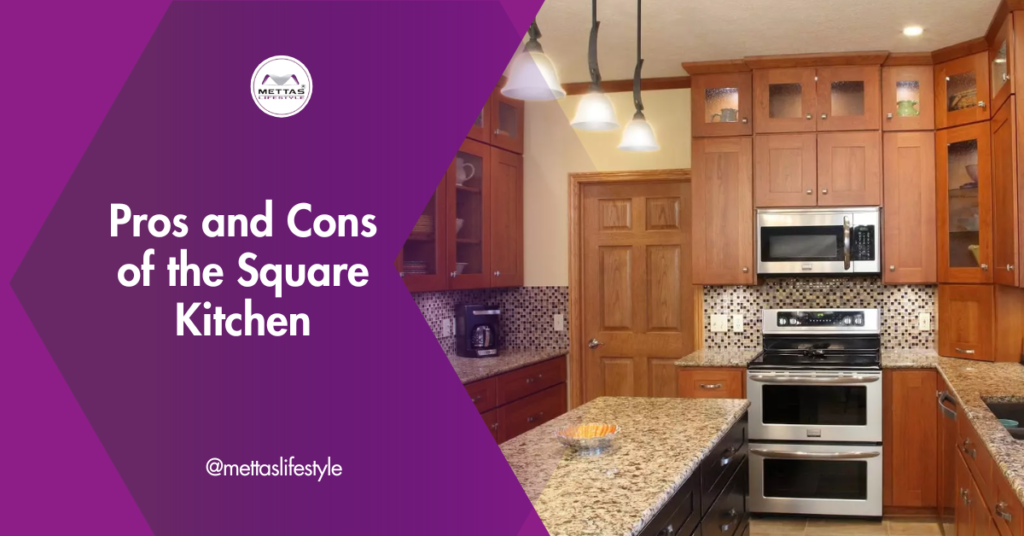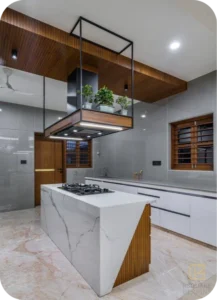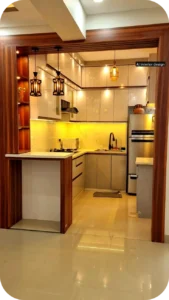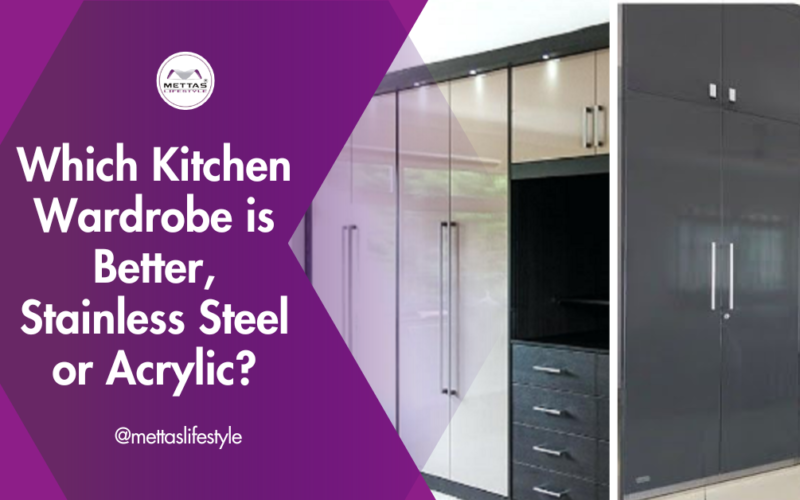

Table of Contents
ToggleIntroduction-Square Kitchen
The kitchen is often considered the heart of the home, and its layout plays a crucial role in its functionality and aesthetics. One popular kitchen design is the square kitchen, characterized by a layout that forms a square or rectangle. This design offers both advantages and disadvantages, making it essential to weigh the pros and cons when considering a square kitchen for your home. In this comprehensive guide, we’ll explore the various aspects of kitchen design to help you make an informed decision by Mettas Lifestyle.
1. Pros of a Square Kitchen
Efficient Workflow
One of the primary advantages of a kitchen layout is its efficient workflow. The design provides a well-organized and balanced workspace, with key elements—such as the stove, sink, and refrigerator—strategically placed on two parallel walls. This arrangement minimizes unnecessary movement and promotes a smooth cooking process. With everything within easy reach, you’ll find it easier to prepare meals efficiently.
Ample Storage Space
Square kitchens often maximize storage opportunities. The two parallel walls create a significant amount of cabinetry and countertop space, allowing you to store kitchen essentials, utensils, cookware, and small appliances without cluttering the area. This abundant storage is particularly beneficial for those with extensive kitchen equipment or a penchant for organization.

Versatile Design Options
Square kitchen layouts are versatile and adaptable to various design styles. Whether you prefer a traditional, modern, or eclectic kitchen, the square design can accommodate your aesthetic preferences. You can easily personalize the space with your choice of cabinetry, countertops, backsplashes, and decor to create a kitchen that suits your taste and complements your home’s overall design.
Symmetrical Aesthetics
The symmetrical nature of square kitchens often appeals to homeowners seeking a balanced and visually pleasing design. The parallel walls create a sense of symmetry that can be aesthetically pleasing and harmonious. This balance can be further enhanced by selecting symmetrical elements such as matching cabinets, lighting fixtures, and even artwork.
Open Concept Integration
Square kitchens can be seamlessly integrated into an open-concept floor plan. By removing walls or incorporating an island or peninsula, you can connect the square kitchens to adjacent living or dining areas, fostering a sense of openness and connectivity. This integration is ideal for homeowners who value socializing while cooking or entertaining guests.
2. Cons of a Square Kitchen
Limited Floor Space
One of the primary drawbacks of a square kitchen is its limited floor space, which can be restrictive for larger households or those who enjoy cooking with family and friends. The compact design may not provide ample room for multiple cooks to work simultaneously, potentially causing congestion during meal preparation.
Insufficient Dining Space
Square kitchens may lack dedicated dining areas, making it challenging to incorporate a dining table or breakfast nook. This limitation can be inconvenient for those who prefer to dine in the kitchen or enjoy casual meals with family members. To address this issue, homeowners may need to allocate space in an adjacent room for dining.

Limited Design Variability
While square kitchens are versatile in terms of design, their layout can limit certain design possibilities. For example, the parallel walls may restrict the placement of large appliances, such as double ovens or oversized refrigerators. Homeowners with specific appliance preferences may find it challenging to accommodate them in a square kitchen.
Potential for Wasted Space
The corners of square kitchens can be challenging to utilize effectively. Corner cabinets, in particular, can be inaccessible or impractical for storing items, resulting in wasted space. Homeowners need to invest in specialized storage solutions, such as lazy Susans or pull-out shelves, to optimize corner space.
Limited Natural Light
Square kitchens may have limited access to natural light, especially if they are situated in the center of a home or do not have large windows. This can make the space feel darker and less inviting. To mitigate this issue, homeowners may need to incorporate additional artificial lighting sources or consider renovation options to introduce more natural light.
In conclusion, the kitchen design offers several advantages, including efficient workflow, ample storage, versatile design options, symmetrical aesthetics, and the potential for open-concept integration. However, it also comes with limitations, such as limited floor space, insufficient dining areas, design constraints, the potential for wasted space, and limited natural light. When considering a square kitchen for your home, it’s essential to assess your specific needs, preferences, and available space to determine if this layout aligns with your lifestyle and functional requirements. By carefully weighing the pros and cons, you can make an informed decision that results in a kitchen design that suits both your practical needs and aesthetic tastes.
3. Design Enhancements for Square Kitchens
While kitchens have their pros and cons, there are several design enhancements and solutions that can help maximize their functionality and aesthetics. By carefully considering these factors, homeowners can address the limitations of the kitchen and create a space that better suits their needs.
Kitchen Islands or Peninsulas
To overcome the limited dining space and promote a sense of openness, consider incorporating a kitchen island or peninsula. These additions can provide a designated dining area within the kitchen. A well-designed island can serve as both a prep space and a breakfast bar, allowing for casual meals and socializing.
Efficient Storage Solutions
To optimize storage in a square kitchen, invest in efficient storage solutions. Use pull-out shelves, lazy Susans, and corner cabinets with rotating trays to make the most of corner spaces. Vertical storage, such as tall pantry cabinets, can maximize storage capacity while minimizing the footprint.
Task Lighting
Address the potential for limited natural light by strategically placing task lighting in key areas of the kitchen. Under-cabinet lighting, pendant lights above the island, and recessed lighting can illuminate the workspace and create a brighter, more inviting atmosphere.
Custom Cabinetry
Consider custom cabinetry designed to fit the unique dimensions of your kitchen. Custom cabinets can make use of every inch of available space, ensuring a tailored and functional storage solution. You can also incorporate features like pull-out spice racks, built-in tray dividers, and drawer organizers to keep the kitchen well-organized.

Modular and Compact Appliances
Choose modular and compact appliances that fit seamlessly into your square kitchen. Look for appliances with slim profiles or built-in designs to save space. For example, under-counter refrigerators or drawer-style dishwashers can help maintain the kitchen’s clean lines and maximize available countertop space.
Reflective Surfaces
To enhance natural light and create a sense of spaciousness, incorporate reflective surfaces into the kitchen’s design. Use glossy backsplashes, mirrored cabinet doors, or stainless steel appliances to bounce light around the room. This can make the square kitchen feel brighter and more open.
Open Shelving
Consider open shelving instead of traditional upper cabinets to create a more open and airy feel. Open shelves can display decorative items and frequently used dishes, adding character to the kitchen while also making items easily accessible. However, keep in mind that open shelving requires consistent organization to maintain a tidy appearance.
Neutral Color Palette
Opt for a neutral color palette for the kitchen’s walls, cabinets, and countertops. Lighter colors, such as whites, creams, or light grays, can make the space feel larger and more inviting. Additionally, neutrals provide a versatile backdrop for various design styles and decor.
Multi-Functional Furniture
Choose multi-functional furniture that serves dual purposes. For example, a dining table with built-in storage can provide both dining space and additional storage for kitchen items. Look for furniture pieces that can be easily adapted to suit the changing needs of your square kitchen.
Consult a Kitchen Designer
If you’re unsure how to optimize your square kitchen’s layout and design, consider consulting a professional kitchen designer. They can provide valuable insights, create a customized design plan, and recommend the most suitable solutions for your specific space and preferences.
Incorporating these design enhancements and solutions can help transform a square kitchen into a highly functional and aesthetically pleasing space. By addressing the limitations and leveraging the strengths of this layout, homeowners can create a kitchen that not only meets their practical needs but also aligns with their style and preferences.
Conclusion
In conclusion, the square kitchens design offers a balanced and efficient workspace, making it a popular choice for many homeowners. Its pros include an efficient workflow, ample storage space, versatile design options, symmetrical aesthetics, and the potential for open-concept integration. However, it also comes with limitations, such as limited floor space, insufficient dining areas, design constraints, the potential for wasted space, and limited natural light.
To make the most of a square kitchens, homeowners can consider design enhancements such as kitchen islands or peninsulas, efficient storage solutions, task lighting, custom cabinetry, modular and compact appliances, reflective surfaces, open shelving, a neutral color palette, multi-functional furniture, and consulting a kitchen designer. These enhancements can help overcome the cons and create a square kitchen that is both functional and visually appealing.
When planning a square kitchens, it’s crucial to assess your specific needs, preferences, and available space to determine if this layout is the right choice for your home. By carefully weighing the pros and cons and implementing appropriate design solutions, you can enjoy a well-organized and beautiful square kitchens that enhances your culinary experiences.
Related topics you must read: Best 5 Ideas for Creating a Sleek L-Shaped Kitchen.
FAQs:
A square kitchen typically ranges from 8 feet by 8 feet to 12 feet by 12 feet, although the size can vary based on individual preferences and available space.
Yes, a square kitchen can accommodate a kitchen island or peninsula to provide additional counter space and a dining area.
You can enhance natural light by using reflective surfaces, light-colored paint, and strategically placed task lighting.
Square kitchens can be an excellent choice for small spaces due to their efficient layout and effective use of space.
Square kitchens are versatile and can accommodate various design styles, including traditional, modern, and eclectic.
Yes, open shelving can be a practical solution to display frequently used items while keeping the kitchen organized.
The cost of designing or renovating a square kitchen can vary depending on materials and design choices but is generally comparable to other kitchen layouts of similar size.
Yes, you can remove walls or create openings to combine a square kitchen with adjacent living or dining areas for an open-concept design.
You can maximize storage by using efficient storage solutions like pull-out shelves, vertical storage, and custom cabinetry.
Consulting a kitchen designer can be highly beneficial to ensure that your square kitchen is well-optimized and tailored to your specific needs and preferences.




